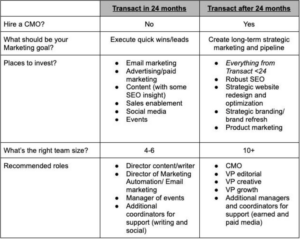Article: Three Questions To Ask Before Hiring A CMO


It’s an exciting time for most growth-stage ($5 million in annual recurring revenue and above) companies when they decide to hire a chief marketing officer. Sales are happening, revenue is finally real, and leadership is ready to scale the product.
The company may have minimal marketing support or what’s been determined as the “wrong marketing” in place, and they believe now is the time for a new strategic direction.
Filled with optimism, leadership finalizes a chief-marketing-officer job description and imagines how this magical marketing savior will descend to start getting revenue to rain down on the company.
The reality is much different and explains why the median tenure of a chief marketing officer has been closer to 27 months for the past few years.
It’s also why I’m constantly hearing from clients, startups, and my contacts in the private-equity and venture-capital world: “Why do we keep hiring the wrong chief marketing officer?”
The answer isn’t that you need a different chief marketing officer. The answer is that the company isn’t ready to hire a chief marketing officer — period.
So how do you know it’s the right time?
1. Do you need a coach or a player?
There is a sentiment I hear all the time among CEOs: “No one can know my business unless they are in it day to day.”
There’s some truth to this statement, but what a chief marketing officer does best is not unique to your business. Much like chief revenue officers aren’t spending their days cold-calling and chief financial officer aren’t setting up basic spreadsheets, chief marketing officers should not be posting on social media, curating email lists, or executing web copy.
You would be wasting their experience and skills.
This is not to say that chief marketing officers are not often “player-coaches,” but to get the “coach” part, you need to provide the right resources: staff and budgets.
What goes into a growth-stage marketing budget?
- Technology stack:
- Marketing automation/customer-relations management
- Analytics/reporting
- Social-media management
- Advertising/paid marketing
- Public relations/earned media
- Social media
- Design
- Content/editorial
- Search-engine marketing/search-engine optimization
- Sales enablement
- Events
There are different schools of thought around whether a marketing budget should include salaries. Because many of the outputs (blogs, social posts, etc.) are usually marketing-staff deliverables, it makes good sense to include staff in the overall number.
The salary of a chief marketing officer should not roll up though; it inappropriately inflates the numbers. As a quick rule of thumb, I like to allocate between 5 and 15% of annual recurring revenue as a good guideline for marketing spend.

2. What’s the timing of your exit event?
When do you want to transact? If you’re the CEO, answer as if you’re the one who’s asking and be brutally honest with yourself.
If you’re transacting in the next 24 months, do not hire a chief marketing officer. Chief marketing officers bring experience, strategy, and a desire to build long-term plans for long-term results. Getting to know the business, the players, and the landscape takes at least six months, and it often takes 12-plus months for real and substantial revenue growth from things like strategic content initiatives.
That doesn’t mean there won’t be quick wins along the way, but truly changing direction takes time.
Below is a useful rubric to explain the areas of marketing that will produce value for your company depending upon your transaction timeline. Transaction is defined as a strategic acquisition, investment round, or partnership with a private-equity or venture-capital firm, or even a merge. In short, a transaction is a major change in leadership or ownership.

3. Will you be able to staff the role appropriately?
“I hired a CMO for $250,000 — they should be bringing me leads,” a client said recently.
But leads don’t happen because of a single person. When you pay for a chief marketing officer, you’re paying for a high-level marketer to be in the business day to day and provide suggestions on how to make strategic long term changes to drive results and success.
Seasoned marketing leaders help set the structure. They put in place the systems, playbooks, and rubrics they’ve used successfully to drive revenue and goals before. Then the junior folks execute on that strategy.
Those companies with longer runway can use the editorial strategy, writing support, and day-to-day interactions of a chief marketing officer to help strengthen the overall brand experience.
If you’re looking to increase leads or test a few different acquisition approaches, consider using a part-time resource to help you set your marketing strategy. Or look inward: Invite your middle-level folks to higher-level meetings and get them even further steeped in the business. You may find there’s a seasoned marketing leader waiting to come out.
If it’s not already clear, the secret to finding the right CMO is time.
As a CEO, the most important conversation is the one with yourself. Do you have a multiyear runway to let your chief marketing officer succeed?
If the answer is no, that’s OK. Put your efforts into creating a team that drives the quick wins needed for a faster transaction.
It’s up to you to be one of the lucky CEOs that hires the right marketing talent at the right time with a much better outcome for you, your business, and your team.
Originally Published In Business Insider
It’s an exciting time for most growth-stage ($5 million in annual recurring revenue and above) companies when they decide to hire a chief marketing officer. Sales are happening, revenue is finally real, and leadership is ready to scale the product.
The company may have minimal marketing support or what’s been determined as the “wrong marketing” in place, and they believe now is the time for a new strategic direction.
Filled with optimism, leadership finalizes a chief-marketing-officer job description and imagines how this magical marketing savior will descend to start getting revenue to rain down on the company.
The reality is much different and explains why the median tenure of a chief marketing officer has been closer to 27 months for the past few years.
It’s also why I’m constantly hearing from clients, startups, and my contacts in the private-equity and venture-capital world: “Why do we keep hiring the wrong chief marketing officer?”
The answer isn’t that you need a different chief marketing officer. The answer is that the company isn’t ready to hire a chief marketing officer — period.
So how do you know it’s the right time?
1. Do you need a coach or a player?
There is a sentiment I hear all the time among CEOs: “No one can know my business unless they are in it day to day.”
There’s some truth to this statement, but what a chief marketing officer does best is not unique to your business. Much like chief revenue officers aren’t spending their days cold-calling and chief financial officer aren’t setting up basic spreadsheets, chief marketing officers should not be posting on social media, curating email lists, or executing web copy.
You would be wasting their experience and skills.
This is not to say that chief marketing officers are not often “player-coaches,” but to get the “coach” part, you need to provide the right resources: staff and budgets.
What goes into a growth-stage marketing budget?
- Technology stack:
- Marketing automation/customer-relations management
- Analytics/reporting
- Social-media management
- Advertising/paid marketing
- Public relations/earned media
- Social media
- Design
- Content/editorial
- Search-engine marketing/search-engine optimization
- Sales enablement
- Events
There are different schools of thought around whether a marketing budget should include salaries. Because many of the outputs (blogs, social posts, etc.) are usually marketing-staff deliverables, it makes good sense to include staff in the overall number.
The salary of a chief marketing officer should not roll up though; it inappropriately inflates the numbers. As a quick rule of thumb, I like to allocate between 5 and 15% of annual recurring revenue as a good guideline for marketing spend.

2. What’s the timing of your exit event?
When do you want to transact? If you’re the CEO, answer as if you’re the one who’s asking and be brutally honest with yourself.
If you’re transacting in the next 24 months, do not hire a chief marketing officer. Chief marketing officers bring experience, strategy, and a desire to build long-term plans for long-term results. Getting to know the business, the players, and the landscape takes at least six months, and it often takes 12-plus months for real and substantial revenue growth from things like strategic content initiatives.
That doesn’t mean there won’t be quick wins along the way, but truly changing direction takes time.
Below is a useful rubric to explain the areas of marketing that will produce value for your company depending upon your transaction timeline. Transaction is defined as a strategic acquisition, investment round, or partnership with a private-equity or venture-capital firm, or even a merge. In short, a transaction is a major change in leadership or ownership.

3. Will you be able to staff the role appropriately?
“I hired a CMO for $250,000 — they should be bringing me leads,” a client said recently.
But leads don’t happen because of a single person. When you pay for a chief marketing officer, you’re paying for a high-level marketer to be in the business day to day and provide suggestions on how to make strategic long term changes to drive results and success.
Seasoned marketing leaders help set the structure. They put in place the systems, playbooks, and rubrics they’ve used successfully to drive revenue and goals before. Then the junior folks execute on that strategy.
Those companies with longer runway can use the editorial strategy, writing support, and day-to-day interactions of a chief marketing officer to help strengthen the overall brand experience.
If you’re looking to increase leads or test a few different acquisition approaches, consider using a part-time resource to help you set your marketing strategy. Or look inward: Invite your middle-level folks to higher-level meetings and get them even further steeped in the business. You may find there’s a seasoned marketing leader waiting to come out.
If it’s not already clear, the secret to finding the right CMO is time.
As a CEO, the most important conversation is the one with yourself. Do you have a multiyear runway to let your chief marketing officer succeed?
If the answer is no, that’s OK. Put your efforts into creating a team that drives the quick wins needed for a faster transaction.
It’s up to you to be one of the lucky CEOs that hires the right marketing talent at the right time with a much better outcome for you, your business, and your team.
Originally Published In Business Insider
